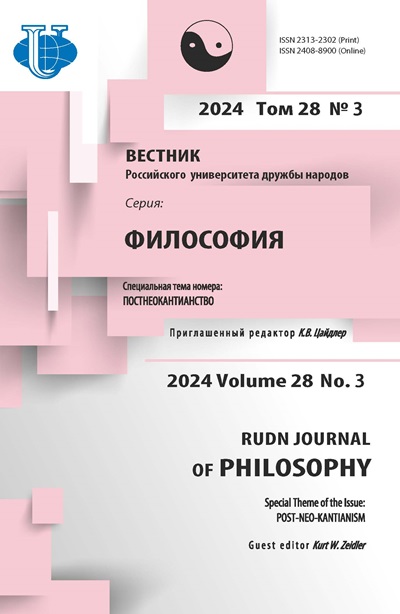Art and Science as a Subject of Aesthetic Epistemology
- Authors: Kolomiets G.G.1
-
Affiliations:
- Orenburg State University
- Issue: Vol 28, No 3 (2024): POST-NEO-KANTIANISM
- Pages: 796-810
- Section: ONTOLOGY AND GNOSEOLOGY
- URL: https://journals.rudn.ru/philosophy/article/view/40992
- DOI: https://doi.org/10.22363/2313-2302-2024-28-3-796-810
- EDN: https://elibrary.ru/WERYKE
Cite item
Full Text
Abstract
The author defines the subject of aesthetic epistemology in the increasingly complex process of a unified meta-system of art, science and technology. Using the concept of “aesthetic epistemology”, the author follows the original premise of aesthetics as a philosophical science in the field of epistemology, discovered by A.G. Baumgarten - the science of sensory cognition, the ability to think beautifully in images, and then enriched by the aesthetic idea of I. Kant, the transcendental ability of aesthetic judgment, requiring entry into creative activity in art and science. The author notes the ambivalence in the views of modern philosophers and physicists on the relationship between art and science, rational and non-logical, logic and intuition, referring to the authority of scientist E.L. Feinberg. At the same time, the idea is emphasized that aesthetic epistemology contributes to the unity of the anthroposocioecological complex meta-system. Attention is drawn to the aesthetic ideal of harmony present in art, science, and technology. Thus, for the musical creativity of modern times, the mathematical complication of sound ratios with the help of modern computer technologies is characteristic, similar to the complication of the dynamics of the development of the whole meta-system of science and art, in which it is important to emphasize the action of the intuitive principle in the aesthetic consciousness of a person. For aesthetic epistemology, the problem of science growing into art is relevant. In modern aesthetics, there is a tendency to reduce the “beautiful” and increase interest in the unusual in art due to new technologies, revealing the secrets of the aesthetic unconscious. Summarizing, the author asserts the idea that aesthetic epistemology determines the forms of modern art and scientific knowledge as a single meta-system and that humanity needs the unity of art, science and technology for the purpose of its existence. This is facilitated by intuition and a deep aesthetic property with the ability of imagination and symbolic thinking. Art and science are rapidly evolving in an increasingly complex integration process aimed at the conscious desire of a person to realize creative ideas based on supersensible, sensual, aesthetic cognition.
About the authors
Galina G. Kolomiets
Orenburg State University
Author for correspondence.
Email: kolomietsgg@yandex.ru
DSc in Philosophy, Honorary Worker of the Sphere of Education of the Russian Federation, Professor, Department of Philosophy, Cultural Studies and Sociology 13 Pobedy Ave, Orenburg, 460018, Russian Federation
References
- Belov VN. S.I. Hessen in the history of Russian Neo-Kantianism. Kant collection. 2014;1(47):59–65. (In Russian). https://doi.org/10.5922/0207-6918-2014-1-4
- Baumgarten AG. Aesthetics. Belousov AV, Shakhov YuA, transl., editors. Moscow: Russian Foundation for the Promotion of Education and Science. Dmitry Pozharsky University Press publ.; 2021. (In Russian).
- Kant I. Criticism of the ability of judgment. Moscow: Iskusstvo publ.; 1994. (In Russian).
- Deleuze J. Kant's Critical Philosophy: the Doctrine of Abilities. In: Empiricism and subjectivity. Kant's critical philosophy. Bergsonism. Spinoza. PER SE; 2001. P. 145–228. (In Russian).
- Sokolova YuV. The relevance of interdisciplinary approaches in the study of consciousness. RUDN Journal of Philosophy. 2023;27(4):848–857. (In Russian).
- Feinberg EL. Two cultures. Intuition and logic in art and science. Fryazino: Vek2 publ.; 2004. (In Russian).
- Kolomiets GG. From the philosophy of “harmony of the world” to the post-non-classical philosophy of music in the context of the phenomenon of transdisciplinarity. Bulletin of the Samara State Technical University. The series “Philosophy”. 2023;5(4):91–96. (In Russian). https://doi.org/10.17673/vsgtu-phil.2023.4.13
- Snow CP. Two cultures. Collection of journalistic works. Rodman NS, transl. Moscow: Progress publ.; 1973. (In Russian).
- Migunov AS, Erokhin SV. Algorithmic aesthetics. Saint Petersburg: Aleteya publ.; 2010. (In Russian).
- Migunov AS. Palette of modern art. In: Philosophy. Culture. Humanism: history and modernity: materials of the international scientific and practical conference (Orenburg, November 9–10, 2006). Orenburg: IPK GOU OSU publ.; 2006. P. 24–29. (In Russian).
- Kagan MS. Aesthetics as a philosophical science. Saint Petersburg: LLP TC “Petropolis” publ.; 1997. P. 15 (In Russian).
- Novikova LI. Aesthetics and technology: alternative or integration? Moscow: Politizdat publ.; 1976. (In Russian).
- Stepin VS. Science. In: The Electronic Library of the IF RAS. The New Philosophical Encyclopedia. Available from: https://iphlib.ru/library/collection/newphilenc/ page/about (accessed: 11.01.2024). (In Russian).
- Vizgin VP. Werner Heisenberg on the relationship between art and science. In: Science and Art. Moscow; 2005. P. 95–120. (In Russian).
- Markova LA. From dialogue to chaos: In science and art. In: Science and Art. Moscow; 2005. P. 133–163. (In Russian).
- Kolomiets GG. Ethics and aesthetics in the aspect of cognition and lifestyle engineering. In: Bagdasaryan NG, Gavrilina EA, editors. The Genius of V.G. Shukhov and the modern Era. Proceedings of the International Congress. Moscow: Publishing House of Bauman Moscow State Technical University; 2015. P. 103–106. (In Russian).
- Kolomiets GG. On the tendency of convergence of scientific and artistic ways of cognition. In: Mironov VV, editor. Scientific art: Materials of the I International Scientific and practical Conference. Lomonosov Moscow State University, April 4–5, 2012. Moscow: IEE; 2012. P. 60–64. (In Russian).
- Kolomiets GG. Man in the technosphere: the interaction of science and art in the aspect of creative human expression. In: IV Russian Cultural Congress with international participation “Personality in the cultural space”. Saint Petersburg, October 29–31, 2013. Abstracts and speeches of the participants. Saint Petersburg: Eidos; 2013. (In Russian).
















